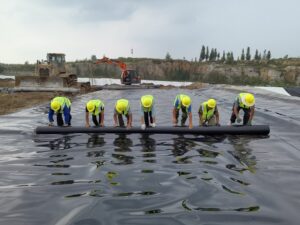A geomembrane is a film or sheet made of plastic material with a certain degree of impermeability and chemical resistance. It is often used in civil engineering to prevent moisture penetration or to block penetration between layers of different materials.
Common geomembrane materials include high-density polyethylene (HDPE), polypropylene (PP), polyester (PET), etc. Different types of geomembranes have different physical and chemical properties and are suitable for different engineering applications.

4 types of factors that affect the cost of geomembranes
Here are some factors that affect the cost of geomembranes:
1. Material type and specification: The cost of geomembrane is affected by the type and specification of the selected material. Different types of geomembranes, such as HDPE (high-density polyethylene), PP (polypropylene), PET (polyester), etc., will have different costs. At the same time, the size and thickness of the specification will also have an impact on the cost, and generally larger sizes and thicker geomembranes cost more.
2. Suppliers and brands: Different suppliers and brands of geomembrane prices will vary. Well-known brands of geomembranes are usually more reliable in quality, but may also be more expensive. When choosing suppliers and brands, factors such as price, quality and reputation need to be considered comprehensively.
3. Project scale and demand: The cost of geomembrane is also related to the project scale and demand. Larger scale projects generally require more geomembrane material, affecting cost. Bulk purchases of geomembranes may provide certain cost advantages.
4. Installation and construction cost: The cost of geomembrane includes not only the price of the material itself, but also the cost of installation and construction. Labor and mechanical equipment may be required during construction, and these costs also need to be taken into consideration.

Geomembrane function and application
It should be noted that the cost of geomembrane is only a part of the total cost of the project, and other costs such as design costs, transportation costs, and construction supervision costs should also be considered comprehensively.
The specific cost of geomembrane needs to be evaluated according to the actual situation. It is recommended to consult the quotations of multiple suppliers when purchasing geomembranes, and compare the cost differences of different brands and specifications, so as to select the appropriate geomembrane and obtain the best cost-effectiveness
Geomembrane has good anti-seepage performance, can prevent the penetration and leakage of water, solute and other substances, and is used to prevent groundwater, chemical substances or waste water from penetrating into the soil or other layers.
Geomembranes can be used to separate layers of different materials and prevent them from mixing and affecting each other. It is often used for the separation between roadbed and soft soil foundation, filling layer and base layer.
Geomembrane can enhance the stability of soil and prevent soil side slope from sliding and subsidence. A geomembrane is placed over the top of the soil or on a slope to provide additional strength and support.
Geomembranes can protect the soil from external environmental factors, such as wind erosion, water erosion, chemical corrosion, etc. It can also be used to protect water conservancy projects, landfills, etc.
Isolation: Geomembranes can prevent mixing and cross-diffusion between different soil layers, maintaining the characteristics and stability of the soil.
Contact Us
[wpforms id=”40″]
Author

Founded in 2002, Tinhy's team focuses on the manufacturing, marketing, installation, application and research and development of geosynthetic materials.
View all posts





